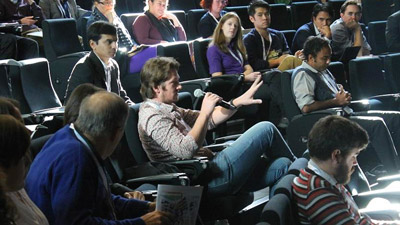.jpg)
The EMCR Forum’s third national Science Pathways meeting was held in Adelaide on April 23-24, 2015. Leanna Read, the Chief Scientist of South Australia, officially opened the meeting, giving context to the theme—effective science communication—by highlighting what the Department of State Development is doing for EMCRs in South Australia. She emphasised the importance of effectively communicating science and targeting the message to the chosen audience.
The Chuwen Keynote Address was given by Heike Ebendorff-Heidepriem in honour of Dr Ben Chuwen, founding member of the EMCR Forum, who passed away in April 2012. As Deputy Director of the Institute for Photonics and Advanced Sensing (IPAS) at the University of Adelaide, Heike has been at the cutting edge of transdisciplinary research in optical materials and structures. She provided examples of collaborations that have required contributions from multiple disciplines, emphasising how stimulating and intellectually challenging these were to establish and maintain.
Session 2 discussed the art of communicating science providing delegates with practical hints and tips to improve their communication with a range of target audiences, including:
This session was very well-received by delegates.
Following lunch, Simon Clews (Director, Writing Centre for Scholars and Researchers, University of Melbourne) delivered an interactive workshop with the intriguing title: ‘What have you got to say and how are you going to say it?’ Simon challenged everyone to think about how they communicate their research and science to different niche audiences. After 40 minutes of excellent practical tips and strategies, homework was set. Delegates were asked to think about what they will do by the end of the week, month and year, and over the next five years, to practise effective science communication.
Session 4 focused on transdisciplinary research featuring Ana Deletic (Director, Monash Water for Liveability, Monash University). With an interest in urban water and sustainable green infrastructure, Ana described how her cooperative research centre (CRC) gradually incorporated experts from disparate disciplines to deal with the complex challenges they face. Four key ingredients for effective communication and interdisciplinary collaboration were highlighted: patience, respect (mutual), simplicity (of communication and language), and positivity and passion.
Afternoon tea was followed by a general homework session where three questions were opened to the floor:
Some great suggestions were put forward, which set the scene for the action plan session scheduled for the end of the meeting on Day 2.
The networking event required delegates to split up into groups for 10 minutes to brainstorm a 60 second pitch on a nominated theme. The resulting presentations were of the highest quality given the limited preparation time, unfamiliar ‘teammates’ from different disciplines, and the pressure of delivering a coherent and effective message in only 1 minute. This certainly made the job of the judges—Dr Melissa McBurnie, Investment Manager, Brandon Capital Partners and Dr Ben McNeil, Founder, Thinkable.org—very challenging. After the winners of the highly-coveted EMCR Forum wine were announced, Ben McNeil officially launched the Thinkable.org ‘Inspire Australia’ video competition open to all EMCRs across Australia, hosted by the EMCR Forum. The current prize pool is $14,007 and growing! To get involved, see the Inpire Australia Research Competition on Thinkable.org.
Day 2 kicked off with a different format, a panel discussion with no slides but with comfy seats and an experienced facilitator in Niall Byrne (Creative Director, Science in Public). The Session 5 panel consisted of an all-star female cast including Reema Rattan (The Conservation), Cassandra McIver (Australian Institute of Policy and Science), Sarah Keenihan (Australian Science Communicators) and Nicky Phillips (Sydney Morning Herald). The journalism panel provided attendees with a lot of very practical useful advice for communicating with and through the media.

Session 6 was delivered by Kristin Alford (Futurist and Founding Director, Bridge8 Pty Ltd), getting everyone to think hard about what a future Australia would look like given different future scenarios (growth, restraint, catastrophe or transformation). With themes including social engagement and inspiring future generations, this session made people think differently and learn how to be better global citizens. John Finnigan then officially launched the Australian Academy of Science’s publication Australia 2050: Structuring conversations about our future (Vol 3 in the series).
Before lunch, a best practice session was delivered by Maggie Hardy (EMCR Forum and University of Queensland) describing how (and why) she set up the Science Ambassador Program at the Institute for Molecular Bioscience (IMB). Maggie also opened up the conversation on ‘alt-metrics’ and how we can measure the impact of science communication. This was the ideal segue into the afternoon session on developing an action plan.
The objective of the action plan session was to get as many different opinions, suggestions and view on the questions raised in the Day 1 Homework session. Short-, mid- and long-term goals and action items were identified by the delegates with an emphasis on individual, institutional and national responsibility. The EMCR Forum most effectively engages at the national level, but can also influence the institutional/individual level. A perfect example of this is the Gender equity: Current issue, best practice and new ideas report (PDF) released by the EMCR Forum in March 2013, which has had a major impact.
You can read the official conference report (PDF) for more details on the conference and how to improve your science communication skills. The EMCR Forum is confident that following this meeting, Australia’s future research leaders will be more effective communicators and powerful advocates for science in Australia.
Dr Andrew Siebel
@Blewey30
Deputy Chair, EMCR Forum Executive
Australian Academy of Science
@EMCRForum
© 2025 Australian Academy of Science